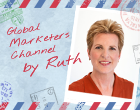マーケティングキャンパス 基礎から実践までB2Bマーケティングを学ぶサイト
ホーム > コラム > ルース教授のグローバル講座 ─Global Marketers Channel by Ruth─ > B2Bコンテンツマーケティングの課題「コンテンツを制限する?それともしない?」 ─To Gate or Not to Gate, That Is the B2B Content Marketing Question ─
2018.09.21

B2Bコンテンツマーケティングの課題「コンテンツを制限する?それともしない?」
─To Gate or Not to Gate, That Is the B2B Content Marketing Question ─
グローバル担当者向け
B2Bマーケティングにおいて、ホワイトペーパーや研究レポートなどの情報を、すべての訪問者に「制限なく」提供するのか、それとも、アンケートに答えてくれた訪問者にだけ提供するのが最善なのかについては、これまでも議論されているテーマです。
聡明で注目される多くのインターネットマーケティングの専門家たちが、Stewart Brand氏に同意しています。「Whole Earth Catalog」の創始者である彼の次の言葉“information wants to be free”(情報は自由になりたがっている)は有名です。そこには、基本的に人は確実に信頼できる企業から物を買うという前提があります。自由で妨害されない情報開示をすることは、信頼関係のみならず、重要で広い情報拡散・共有を促進する可能性もあります。情報を開示することは、非常に大量のリードにアプローチできるようになり、それらのリードにビジネスの課題解決策を提供することができます。さらにそれらのリードは無料で開示された情報に感謝し、買う準備ができたときには情報を開示してくれた企業を想起してくれるかもしれません。
問題なのは、「インバウンドマーケティング」のもとにあるこのモデルが、マーケターを深刻な板挟みにしてしまうことです。マーケターは、有益な情報を読んでいる人が誰なのかを知るすべはありません。これらの潜在的なリードとの関係を築いていくためのステップを進めることはできず、ただじっとしているしかないのです。マーケターにできることは、リードの方からの問い合わせやRFP(提案依頼)を待つだけです。または、リードに対してさらに多くの情報や課題解決策を提供していくしかありません。このような方法は、売上目標を達成することはもちろん、ビジネス関係を維持・向上させる方法とは言えず、成り行き任せにすぎません。
インバウンドマーケティングにおけるROIモデルでは、限られた層にだけコンテンツ開示するより、幅広い層にコンテンツを開示する方が、売上向上につながるということが言われています。これらの数字がどのように動いているか見てみましょう。
一般的に、リードとコミュニケーションを始めるためには、無料ダウンロードや閲覧を通して10,000件のリードに幅広く情報開示すべきだと言われています。一方、コンテンツに制限をかけて、ダウンロードを試みる訪問者に連絡先の情報を求めた場合、全体の1%すなわち100件のリードに情報を開示できます。これらは正当なリードのため、マーケターはアウトバウンドコミュニケーションをとることができます。 典型的なキャンペーンのコンバージョン率を適用すると、100件の問い合わせのうち20%、すなわち20件が有望見込み客として絞り込めるだろうと予測できます。そのうち、50%、すなわち10件にコンタクトすることができ、さらにその20%がコンバージョンした場合、2件の売上に繋がるでしょう。
しかし、マーケターが直接つながりを持たない10,000人のうち、どれだけの売り上げを創出できるのか、明言することは簡単ではありません。問い合わせがあった際、どこで自社を認知したのか、アンケートで尋ねた場合、そのうち何人かは確実にホワイトペーパーなど、マーケターが提供したコンテンツを挙げるでしょう。しかし、このデータは信頼できない傾向があります。問い合わせした人は通常、どのようにして情報を知ったのかをはっきりと覚えていない場合があります。また、適当に回答することもあるでしょう。
まさにこれが、ビジネスマーケターがこのテーマについて悩み、議論している理由です。私たちには、制限をかけたコンテンツの場合のデータと証拠はありますが、制限をかけずに提供したコンテンツの場合については、推測するしかありません。そのため、自分がどちらかを「信じる」としか言えません。信念に基づいて持続可能なマーケティングをすることは難しいのです。
私自身、測定可能なダイレクトマーケティングとデータベースマーケティングの世界で、マーケターとして成長してきました。そのため、私がコンテンツを制限する立場を好むのは驚くことではありません。私は、予測可能な結果をもたらすマーケティングキャンペーンを好みます。なぜなら、キャンペーンの回答率やコンバージョン率、コストパーリードの数字なら、私は堂々と主張することができるからです。また、売上ノルマを達成するために私を信頼してくれている営業担当者に対して、絞り込んだリードを安定して供給できることを合理的に予測できるという点が、最も重要なのです。
以上が、B2Bマーケティングにおいてコンテンツに制限をかけることに関する私の主張です。逆側の論理も理解しており、それが効果的な状況であることは分かっています。例えば、ティザーなどでより質の高い有益な情報を提供すると説明すれば、名前、役職、会社名やメールアドレスを入力したいと思う訪問者もいるかもしれません。
あなたはどうですか。この議論において、どちらの立場でしょうか、とても重要な課題です。
ルース・スティーブンス プロフィール
アメリカのBtoBマーケティングを代表するコンサルタント
コロンビア大学客員教授。イーマーケティングストラテジー社 代表取締役。
コロンビア大学経営大学院卒業、MBA取得。タイム・ワーナー社、ジフ・デイビス社、IBM社などでマーケティングの要職を歴任。米国のBtoBマガジンで最も影響力のある100人のひとり、またリードマネジメント協会の注目すべき女性20人にも選ばれている。数多くのメディアにもブロガーとして寄稿し、B2Bマーケティングをテーマにした多くの著書がある。
There’s a spirited debate in B2B marketing about whether it’s best to give away information (aka “content”, like white papers and research reports) to all comers, versus requiring web visitors to provide some information in exchange for a content download. In other words, to gate your content or not to gate. The debate involves aspects of both ROI and philosophy. Myself, I lean toward the “gate it” camp, and here’s why.
I know that plenty of very smart and well-respected Internet marketing experts line up with dear old Stewart Brand, founder of the Whole Earth Catalog, who famously said in 1984 that information “wants to be free”. The underlying assumption there is that people buy from companies that they trust─a valid point, to be sure. Casting a net through free─unimpeded─distribution of content encourages both trust and, perhaps more importantly, wide dispersal and sharing of information. You’ll get to a much bigger audience, who will be educated on the solutions to their business problems, will be grateful for the free info and, one hopes, will think of you when they’re ready to buy. So far, so good.
The problem is that this model─which lives under the umbrella concept known as “inbound marketing”─leaves marketers in a serious quandary. We don’t have any way of knowing who is reading our informative, educational and helpful content. We are left sitting on our thumbs, unable to take any proactive steps toward building relationships with these potential prospects. All we can do is wait for them to contact us and, we hope, ask us to participate in an RFP process, or, more likely, give them more info and more answers to their questions. Is that any way to sustain and grow a business relationship─not to mention meet a revenue target? In my view, it leaves too much to chance.
Let’s look at the numbers. The ROI model for inbound marketing says that distributing the content to a wide audience will eventually result in more sales than gating the content and marketing proactively to a smaller universe. Let’s look at how these numbers might actually work:
To start the conversation, say that wide distribution would put your content in front of 10,000 prospects, via free downloads and pass-along. In contrast, we might similarly assume that by gating, and requiring some contact information in exchange for the content download, we would only get 1% of that distribution: 100 prospects. These are now legitimate inquirers, and we can conduct outbound communications to them. By applying typical campaign conversion rates, we could predict that of 100 inquiries, 20% will qualify─producing 20 qualified leads. Of those, we’ll be able to contact 50% (or 10), and of them 20% will convert, resulting in 2 sales.
But how many sales will we get from the 10,000 with whom we have no direct connection? It’s hard to say. When inquiries come in, we can ask where they heard of us, and certainly some will say they read the white paper, or whatever content we put into circulation. But this data tends to be unreliable. Inquirers usually don’t remember how they heard of you, or they just make up an answer to get the question out of the way.
This is exactly why business marketers debate the subject with such vigor. We have data, and thus proof, on the gating side. But we only have conjecture on the other. So it boils down to which side you believe. It’s tough to do sustainable marketing on faith.
Myself, I grew up as a marketer in the world of measurable direct and database marketing. So it’s no surprise that I favor the gating side of the fence. I like marketing campaigns that provide predictable results. Where I can stand up in court and show a history of my campaign response rates, conversion rates, and cost-per-lead numbers. And most important, where I can reasonably expect to deliver a steady stream of qualified leads to my sales counterparts, who are relying on me to help them meet their quotas.
So that’s my argument for gating content in B2B marketing. I understand the logic of the other side. And I see clearly situations where it makes sense to let the information run free─as a teaser, for example, to persuade prospects to come and get the richer information that is so useful that they’ll be falling all over themselves to give me their name, title, company name and email address.
But what about you? Where do you sit in this debate? It’s a biggie.
Ruth P. Stevens Bio
Ruth P. Stevens consults on customer acquisition and retention, teaches marketing at business schools in the U.S. and abroad, and is a guest blogger at Biznology and Target Marketing Magazine, and a contributing writer at AdAge. Crain’s BtoB magazine named Ruth one of the 100 Most Influential People in Business Marketing. Her newest book is B2B Data-Driven Marketing: Sources, Uses, Results. Ruth has held senior marketing positions at Time Warner, Ziff-Davis, and IBM and holds an MBA from Columbia University. Learn more at www.ruthstevens.com.